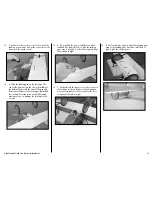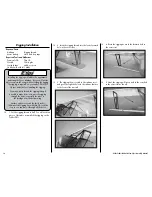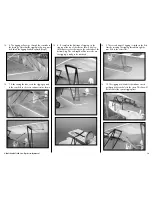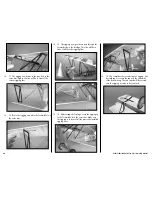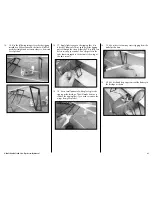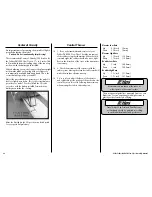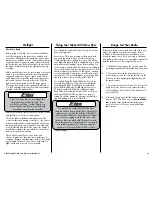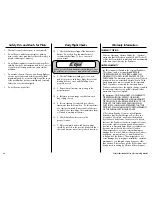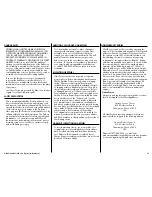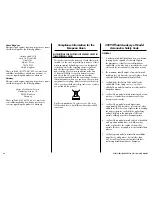
23
E-flite Fokker DVII 250 Slow Flyer Assembly Manual
Preflight
Check Your Radio
Before going to the field, be sure that your batteries
are fully charged per the instructions included with
your radio. Charge both the transmitter and receiver
pack for your airplane. Use the recommended charger
supplied with your particular radio system, following
the instructions provided with the radio. In most cases,
the radio should be charged the night before going
out flying.
Before each flying session, be sure to range check your
radio. See your radio manual for the recommended
range and instructions for your radio system. Each
radio manufacturer specifies different procedures for
their radio systems. Next, start the motor. With the
model securely anchored, check the range again.
The range test should not be significantly affected. If
it is, don’t attempt to fly! Have your radio equipment
checked out by the manufacturer.
Keep loose items that can get entangled in
the propeller away from the prop. These
include loose clothing, or other objects such
as pencils and screwdrivers. Especially keep
your hands away from the propeller.
Double-check that all controls (aileron, elevator, rudder
and throttle) move in the correct direction.
Check the radio installation and make sure all the
control surfaces are moving correctly (i.e., the correct
direction and with the recommended throws). Test run
the motor and make sure it transitions smoothly from
off to full throttle and back. Also ensure the engine is
installed according to the manufacturer’s instructions,
and it will operate consistently.
Check all the control horns, servo horns, and
clevises to make sure they are secure and in good
condition. Replace any items that would be considered
questionable. Failure of any of these components in
flight would mean the loss of your aircraft.
Flying Your Fokker DVII Slow Flyer
You will find the Fokker DVII Slow Flyer to be a solid,
honest-flying model.
Ensure your CG is set according to the manual and
power up the aircraft. Move your throttle trim up
slowly until the motor just begins to spin. This will be
your flight idle that will help to establish a longer glide
path and to make landings easier. Before taxiing out
to the runway, double-check all controls are working in
the correct direction and functioning properly. You will
find the rudder very effective; on the ground, tracking
is very predictable. Apply power smoothly and begin
the takeoff roll. Correct with rudder as necessary and
apply up elevator slowly until the model lifts off.
You will find flying the Fokker DVII Slow Flyer to be
very relaxing and easy. The model is not designed
for high-speed flight. Most flight is accomplished
below half throttle and will yield flights in excess of
20 minutes with an 800mAh 2-cell battery with a
Park 250 when outfitted with the GWS 7 x 3.5 prop.
Landing the Fokker DVII Slow Flyer is as easy as
setting up on final approach, lowering the throttle to
idle and gliding in to a soft touch-down.
You will find the Fokker DVII 250 Slow Flyer
capable of basic loops and stall turns. Flying these
maneuvers is easy and fun with the Fokker DVII
250 Slow Flyer. After your first flight you will want
to check your rigging to make sure none of the
locations that were glued with CA have loosened.
Check these areas on a regular basis to ensure safe
and reliable operation. We hope you enjoy the
experience of flying the Fokker DVII Slow Flyer.
Happy landings.
Range Test Your Radio
Before each flying session, and especially with a new
model, it is important to perform a range check. It
is helpful to have another person available to assist
during the range check. If you are using a Spektrum
transmitter, please refer to your transmitter’s manual for
detailed instructions on the range check process.
1. With the model resting on the ground, stand 30
paces (approximately 90 feet) away from the model.
2. Face the model with the transmitter in your
normal flying position. Be sure the throttle is in the
full down position and plug the flight battery into
the speed control.
3. As you move the controls, watch to be sure the
airplane’s motor and controls operate smoothly.
You should have total control of the model at 30
paces (90 feet).
4. If control issues exist, call the Horizon Support
Team at 1 877 504 0233 or go to
horizonhobby.
com
to find a local Spektrum distributor in your
country for service if you are using a Spektrum
radio system.









